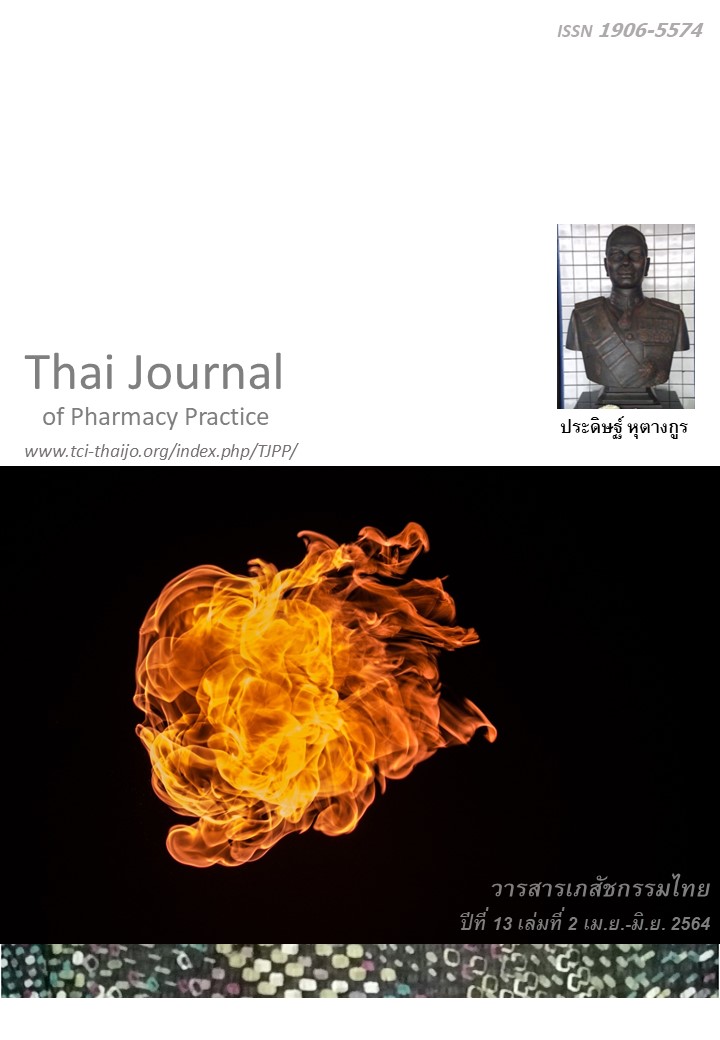การศึกษาขั้นต้นถึงประสิทธิผลและความปลอดภัยของสารสกัดประสะเปราะใหญ่ ในผู้ป่วยจมูกอักเสบจากภูมิแพ้ที่มีระดับความรุนแรงของโรคปานกลางถึงมาก
Main Article Content
บทคัดย่อ
วัตถุประสงค์: เพื่อศึกษาประสิทธิผลและความปลอดภัยเบื้องต้นของการใช้ยาแคปซูลสารสกัดประสะเปราะใหญ่ขนาด 300 มิลลิกรัมในอาสาสมัครกลุ่มเล็กที่มีอาการเยื่อบุจมูกอักเสบจากภูมิแพ้ที่มีระดับความรุนแรงของโรคปานกลางถึงมาก วิธีการ: รูปแบบงานวิจัยเป็นแบบกึ่งทดลองในอาสาสมัคร 20 คน ที่มีอาการเยื่อบุจมูกอักเสบจากภูมิแพ้ได้แก่ คัดจมูก คันจมูก จามและน้ำมูกไหล อยู่ในระดับปานกลางถึงมาก อาสาสมัครได้รับประทานยาแคปซูลสารสกัดประสะเปราะใหญ่ ขนาด 100 มิลลิกรัม ครั้งละ 1 เม็ด หลังอาหาร เช้า กลางวัน และเย็น เป็นเวลา 6 สัปดาห์ การศึกษาประเมินประสิทธิผลเบื้องต้นจากการเปลี่ยนแปลงหลังรับประทานยาของอาการทางจมูกด้วยแบบประเมินอาการโดยรวมทางจมูก พื้นที่หน้าตัดขวางของโพรงจมูก และปริมาตรของโพรงจมูกด้วยเครื่อง acoustic rhinometry ร่วมกับการประเมินคุณภาพชีวิตด้วยแบบประเมินคุณภาพชีวิตเฉพาะโรคจมูกและตาอักเสบจากภูมิแพ้ (RCQ-36) รวมทั้งการประเมินความปลอดภัยจากการสอบถามอาการข้างเคียงที่เกิดขึ้น ร่วมกับประเมินค่าการทำงานของตับและไต ผลการวิจัย: หลังจากรับประทานยา 6 สัปดาห์ อาสาสมัครมีคะแนนอาการโดยรวมทางจมูกลดลงอย่างมีนัยสำคัญทางสถิติจาก 6.40±1.00 ในสัปดาห์ที่ 0 เป็น 4.15±1.98 ในสัปดาห์ที่ 6 ตัวอย่างมีคุณภาพชีวิตที่ดีขึ้นโดยมีคะแนนผลกระทบของโรคลดลงอย่างมีนัยสำคัญทางสถิติ (3.10±.45 เป็น 2.50±.89) พื้นที่ภาคตัดขวางและปริมาตรของโพรงจมูกยังมีแนวโน้มเพิ่มแต่ไม่มีความแตกต่างทางสถิติ การสอบถามอาการข้างเคียงพบว่า มีอาสาสมัครเพียง 1 คนที่มีอาการเรอ อาสาสมัครทุกคนมีค่าการทำงานของตับและไตอยู่ในเกณฑ์ปกติ สรุป: ผลการศึกษาครั้งนี้สามารถนำไปต่อยอดในการวิจัยทางคลินิกระยะที่ 2 เพื่อศึกษาประสิทธิผลและความปลอดภัยต่อไป
Article Details
ผลการวิจัยและความคิดเห็นที่ปรากฏในบทความถือเป็นความคิดเห็นและอยู่ในความรับผิดชอบของผู้นิพนธ์ มิใช่ความเห็นหรือความรับผิดชอบของกองบรรณาธิการ หรือคณะเภสัชศาสตร์ มหาวิทยาลัยสงขลานครินทร์ ทั้งนี้ไม่รวมความผิดพลาดอันเกิดจากการพิมพ์ บทความที่ได้รับการเผยแพร่โดยวารสารเภสัชกรรมไทยถือเป็นสิทธิ์ของวารสารฯ
เอกสารอ้างอิง
Kimihiro O, Yuichi K, Keniichi I, Tadao E, Yoshitaka O, Hideyuki K, Harumi S, Shigeharu F, Keisuke M and the Japanese Society of Allergology. Japanese guidelines for allergic rhinitis 2017. Allergol Int 2017 ; 66: 205-19.
Kirtsreesakul V. The prevalence of rhinosinusitis in allergic rhinitis. Songklanagarind Medical Journal. 2006; 24: 299-304.
Bunnag C, Jareoncharsri P, Tantilipikorn P, Vichya nond P, Pawankar R. Epidemiology and current status of allergic rhinitis and asthma in Thailand - ARIA Asia-Pacific Workshop report. Asian Pac J Allergy Immunol. 2009; 27: 79-86.
Mukta O. Self-care Behavior in patients with allergic rhinitis at Phatthalung Hospital. Region 11 Medical Journal. 2015; 29: 615-20.
Chinratanapisit S, Suratannon N, Pacharn P, Sritipsu kho P, Vichyanond P. Prevalence and risk factors of allergic rhinitis in children in Bangkok area. Asian Pac J Allergy Immunol. 2019; 37: 232-9.
Thai Rhinological Society. Clinical practice guidelines of Thai allergic rhinitis pateints (update 2011) [on line]. 2011 [cited Feb 24, 2020]. Available from www.rcot.org/datafile/_file/_doctor/88b81f499ea324fd1c861b51bbb2fcbd.pdf
Ministry of Health, Thailand. National list of essential medicines 2013. [online]. 2013 [cited Feb 24, 2020]. Available from: drug.fda.moph.go.th:81/nle m.in.th/.
Mukkasombut N, Chanvimalueng W, Makchuchit S, Itharat A. Correlation of biological activities on different extraction period times and stability study of Pra-sa-prao-hyai remedy. Thammasat Medical Journal 2013; 13: 504-12.
Mukkasombut N, Pipatrattanaseree W, Itharat A. Validation of HPLC method for the determination of anti-allergic compounds in ethanolic extract of prasaprohyai remedy, a Thai traditional medicine. Thammasat Medical Journal 2020; 20: 74-83.
Makchuchit S, Ruangnoo S, Itharat A. Investigation of anti-allergic and anti-inflammatory activities of Prasaprohyai ethanolic extract under forced degradation and accelerated storage conditions. Thammasat Medical Journal 2019; 19: 371-84.
Plengsuriyakarn T, Viyanant V, Eursitthichai V, Picha P, Kupradinun K, Itharat A, et al. Anticancer activities against cholangiocarcinoma, toxicity and pharmacological activities of Thai medicinal plants in animal models. BMC Complement Altern Med 2012; 12: 23. doi: 10.1186/1472-6882-12-23.
Siriruthawong S. Chronic toxicity testing for Prasa prayai remedy extract. In: Itharat A, editor. Drug development on Prasarauyai remedy extract for allergic diseases. Pathumtani: Thammasat Univer- sity; 2016.
Mukkasombut N. Comparison of efficacy between pra-sa-prao-hyai powder and loratadine in allergic rhinitis patients [dissertation]. Pathumtani: Thamma sat University; 2013.
Mukkasombut N, Chanvimalueng W, Itharat A, Budsaba K, Ooraikul B. Clinical trial phase I of prasaprohyai extract capsules. J Med Assoc Thai 2020; 103: 94.
Thai Pharmacopoeia Commission. Thai herbal Phar macopoeia. Nonthaburi: Department of Medical Sciences 2018; 623-754.
Komoltri C. Sample size calculation. Journal of Mental Health of Thailand 2012; 20: 192-8.
Brożek JL, Bousquet J, Agache I, Agarwal A, Bachert C, Bosnic-Anticevich S et al. Allergic Rhinitis and its Impact on Asthma (ARIA) guide lines-2016 revision. J Allergy Clin Immunol. 2017; 140: 950-8. doi:10.1016/j.jaci.2017.03.050
Ellis AK, Soliman M, Steacy L, et al. The Allergic Rhinitis - Clinical Investigator Collaborative (AR-CIC): nasal allergen challenge protocol optimization for studying AR pathophysiology and evaluating novel therapies. Allergy Asthma Clin Immunol. 2015; 11: 16. doi:10.1186/s13223-015-0082-0
Bunnag C, Leurmarnkul W, Jareoncharsri P, et al. Development of a health-related quality of life ques- tionnaire for Thai patients with rhinoconjunc tivitis. Asian Pac J Allergy Immunol. 2004; 22: 69-79.
Thanasumpun T, Assanasen P. Nasal obstruction. [online]. 2017 [cited May 18, 2020]. Available from www.rcot.org/pdf/Nasal_Obstruction06-10-2017.pdf
Food and Drug Administration. Allergic rhinitis: Deve loping drug products for treatment guidance for industry. [online]. 2018 [cited May 18, 2020]. Available from: www.fda.gov/media/71158/down load.
Ungkhara G, Chanasriyotin C, Teerasuwanajuk N. The mucociliary function and nasal obstructive symptoms in allergic rhinitis patients. Vajira Medical Journal. 2016; 60: 15-22.
Tunsaringkarn T, Palanuvej C, Rungsiyothin A, et al . Pharmacognostic specification of Kaempferia galanga Rhizome in Thailand. Journal of Health Research. 2007; 21: 207-14
Tantilipikorn P, Saisombat P, Phonpornpaiboon P, Pinkaew B, Lermankul W, Bunnag C. Minimal clinically important difference for the rhinoconjunc tivitis quality of life questionnaire in allergic rhinitis in Thai population. Asia Pac Allergy. 2019; 9: e6.


